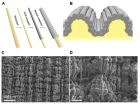(Press-News.org) New research has revealed abrupt warming, that closely resembles the rapid man-made warming occurring today, has repeatedly played a key role in mass extinction events of large animals, the megafauna, in Earth's past.
Using advances in analysing ancient DNA, radiocarbon dating and other geologic records an international team led by researchers from the University of Adelaide and the University of New South Wales (Australia) have revealed that short, rapid warming events, known as interstadials, recorded during the last ice age or Pleistocene (60,000-12,000 years ago) coincided with major extinction events even before the appearance of man.
Published today in Science, the researchers say by contrast, extreme cold periods, such as the last glacial maximum, do not appear to correspond with these extinctions.
"This abrupt warming had a profound impact on climate that caused marked shifts in global rainfall and vegetation patterns," said University of Adelaide lead author and Director of the Australian Centre for Ancient DNA, Professor Alan Cooper.
"Even without the presence of humans we saw mass extinctions. When you add the modern addition of human pressures and fragmenting of the environment to the rapid changes brought by global warming, it raises serious concerns about the future of our environment."
The researchers came to their conclusions after detecting a pattern, 10 years ago, in ancient DNA studies suggesting the rapid disappearance of large species. At first the researchers thought these were related to intense cold snaps.
However, as more fossil-DNA became available from museum specimen collections and through improvements in carbon dating and temperature records that showed better resolution through time, they were surprised to find the opposite. It became increasingly clear that rapid warming, not sudden cold snaps, was the cause of the extinctions during the last glacial maximum.
The research helps explain further the sudden disappearance of mammoths and giant sloths that became extinct around 11,000 years ago at the end of the last ice age.
"It is important to recognize that man still played an important role in the disappearance of the major mega fauna species," said fellow author Professor Chris Turney from the University of New South Wales.
"The abrupt warming of the climate caused massive changes to the environment that set the extinction events in motion, but the rise of humans applied the coup de grace to a population that was already under stress."
In addition to the finding, the new statistical methods used to interrogate the datasets (led by Adelaide co-author Professor Corey Bradshaw) and the new data itself has created an extraordinarily precise record of climate change and species movement over the Pleistocene.
This new dataset will allow future researchers a better understanding of this important period than has ever been possible before.
INFORMATION:
For more information or to arrange an interview contact:
Researchers:
*Prof Alan Cooper
The University of Adelaide
(currently in the US)
Phone: +61 406 383 884
Email: alan.cooper@adelaide.edu.au
* Prof Alan Cooper is currently working in Natural Trap Cave, Wyoming (United States) where many fossilised remains of past megafauna have been discovered.
Prof Chris Turney
University of New South Wales
Phone: +61 408 678 989
Email: c.turney@unsw.edu.au
Media officers:
Robyn Mills
The University of Adelaide
Phone: +61 8 8313 6341
Mobile: +61 410 689 084
Email: robyn.mills@adelaide.edu.au
Alvin Stone
University of New South Wales
Phone: +61 2 9385 8953
Mobile: +61 418 617 366
Email: alvin.stone@unsw.edu.au
A multi-institutional team of researchers has identified an apparently successful treatment for a genetic immune disorder that causes a multitude of health problems - ranging from infections, diabetes, lung disease and the body's immune system attacking and damaging healthy tissues.
Led by Cincinnati Children's Hospital Medical Center and the National Institute of Allergy and Infectious Diseases (NIAID), the researchers report in the July 24 edition of Science a promising therapy for a disorder called LRBA deficiency. They tested the drug abatacept - already FDA-approved ...
This news release is available in Japanese.
The discovery of a four-legged fossil of a snake hints that this suborder may have evolved from burrowing, rather than marine, ancestors. The unique four-legged specimen, found in Brazil's Crato Formation, provides us with more insight into how these creatures transitioned into the sleek, slithering reptiles that we are familiar with - and often fearful of - today. By analyzing both the genetics and the morphological features of this species compared to other known snake species, and giving different weight to ...
This news release is available in Japanese.
In the race to produce highly stretchable conductors, researchers have developed a new technique that aligns sheets of layered carbon nanotubes along stretched rubber cores, creating an extremely flexible conductive fiber. From pacemaker leads to flexible displays and batteries, there is a growing need for fibers that don't lose their conductivity upon repeated stretching, twisting or flexing. The challenge has been to create a conductive material that is highly elastic, but that maintains a high level of ...
Scientists have identified a critical function of what they believe to be schizophrenia's "Rosetta Stone" gene that could hold the key to decoding the function of all genes involved in the disease.
The breakthrough has revealed a vulnerable period in the early stages of the brain's development that researchers hope can be targeted for future efforts in reversing schizophrenia.
In a paper published today in the journal Science, neuroscientists from Cardiff University describe having uncovered the previously unknown influence of a gene in ensuring healthy brain development.
The ...
COLLEGE PARK, Md. - Do you have gender "faultlines" in your organization? New research suggests that such fissures appear when gender differences solidify into cliques. And this tends to occur when members of one gender share other demographic traits and professional interests, such as age, job responsibilities and time served. For example, the men in one organization might be young techies, while the women might tend to be middle-aged marketers. Or vice versa. What's important is that several qualities align in addition to gender, creating a stronger sense of in-group ...
ANN ARBOR--A new University of Michigan study finds that teens using marijuana for medical reasons are 10 times more likely to say they are hooked on marijuana than youth who get marijuana illegally.
The study is the first to report on a nationally representative sample of 4,394 high school seniors and their legal or illegal medical marijuana use as it relates to other drug use. In the study, 48 teens had medical marijuana cards, but 266 teens used medical marijuana without a card.
Carol Boyd, the study's lead author and professor at the U-M School of Nursing, said ...
MADISON, Wis. -- University of Wisconsin-Madison engineers have developed a new approach to structuring the catalysts used in essential reactions in the chemical and energy fields. The advance offers a pathway for industries to wean themselves off of platinum, one of the scarcest metals in the earth's crust.
In an effort to reduce the catalysis world's dependence on this highly reactive and versatile -- but also quite expensive -- metal, UW-Madison chemical engineering Professor Manos Mavrikakis and his collaborators have turned to the nanoscale structure of particles, ...
MADISON, Wis. -- If you have two working eyes, you are live streaming two images of the world into your brain. Your brain combines the two to produce a view of the world that appears as though you had a single eye -- like the Cyclops from Greek mythology.
And that's a good thing, as the combination of the two images makes for a much more useful impression of the world. With one eye shut, catching a ball or parking a car become far more difficult.
"If you're reaching out with your hand, you want to aim not at where things appear to be, but where they are," says Bas Rokers, ...
Everybody grieves the death of a loved one, and the process helps most mourners adjust to their loss.
"Charlie Brown was right," said Christopher Layne, a psychologist and researcher at the Semel Institute for Neuroscience and Human Behavior at UCLA. "There is good grief."
But for some people, bereavement becomes a problem in itself, prolonging suffering and impairing functioning. For grieving children and adolescents persistent complex bereavement disorder can derail social and academic development at a time when children and adolescents need to master skills and form ...
PULLMAN, Wash.--Washington State University scientists have found that glyphosate, the main ingredient in the herbicide Roundup, does not accumulate in mother's breast milk.
Michelle McGuire, an associate professor in the WSU School of Biological Sciences, is the lead researcher of the study, the first to have its results independently verified by an accredited, outside organization.
Her findings, presented at the Federation of American Societies for Experimental Biology Conference on July 23 in Big Sky, Mont., show that glyphosate, the most used weed-killing chemical ...




